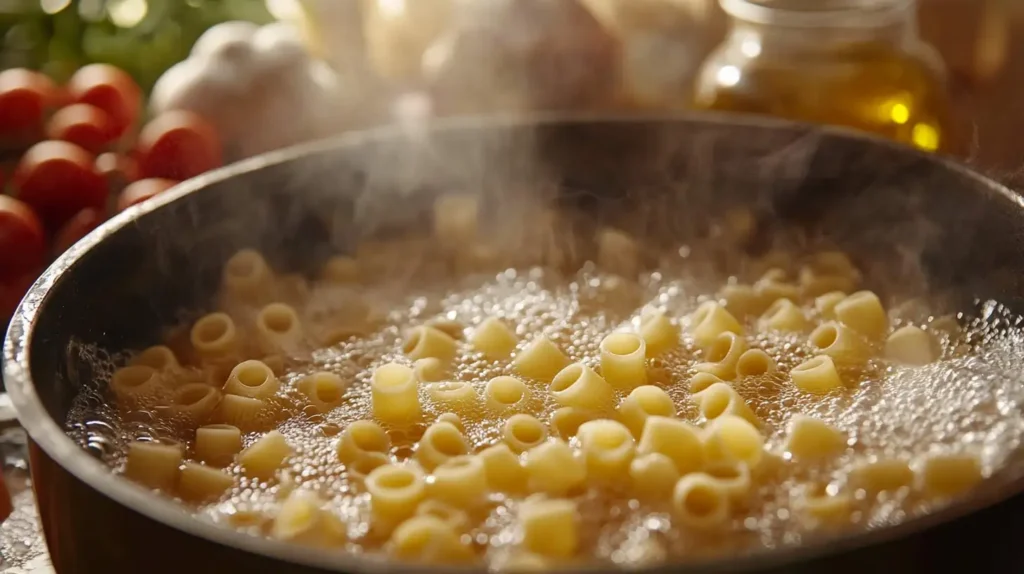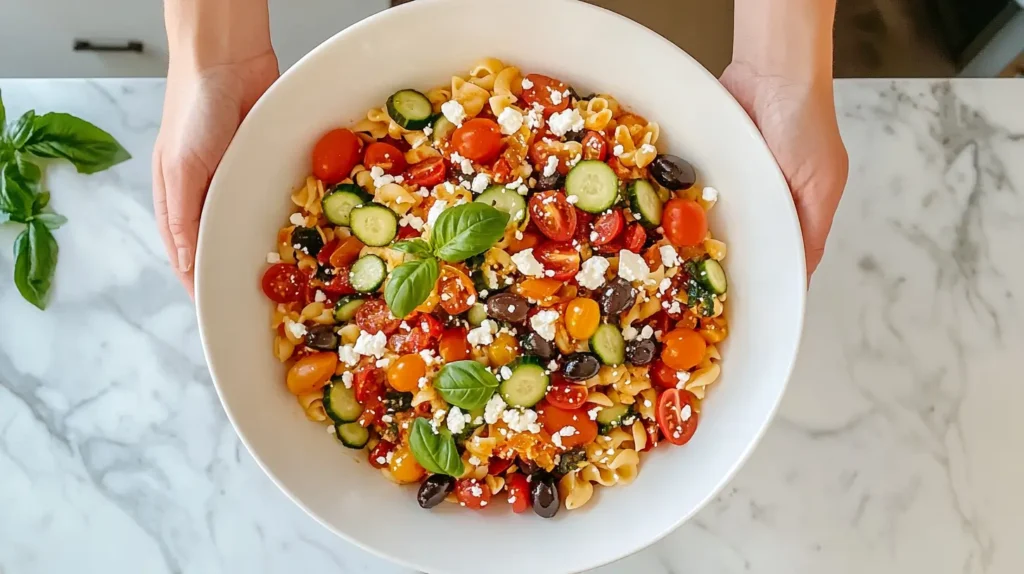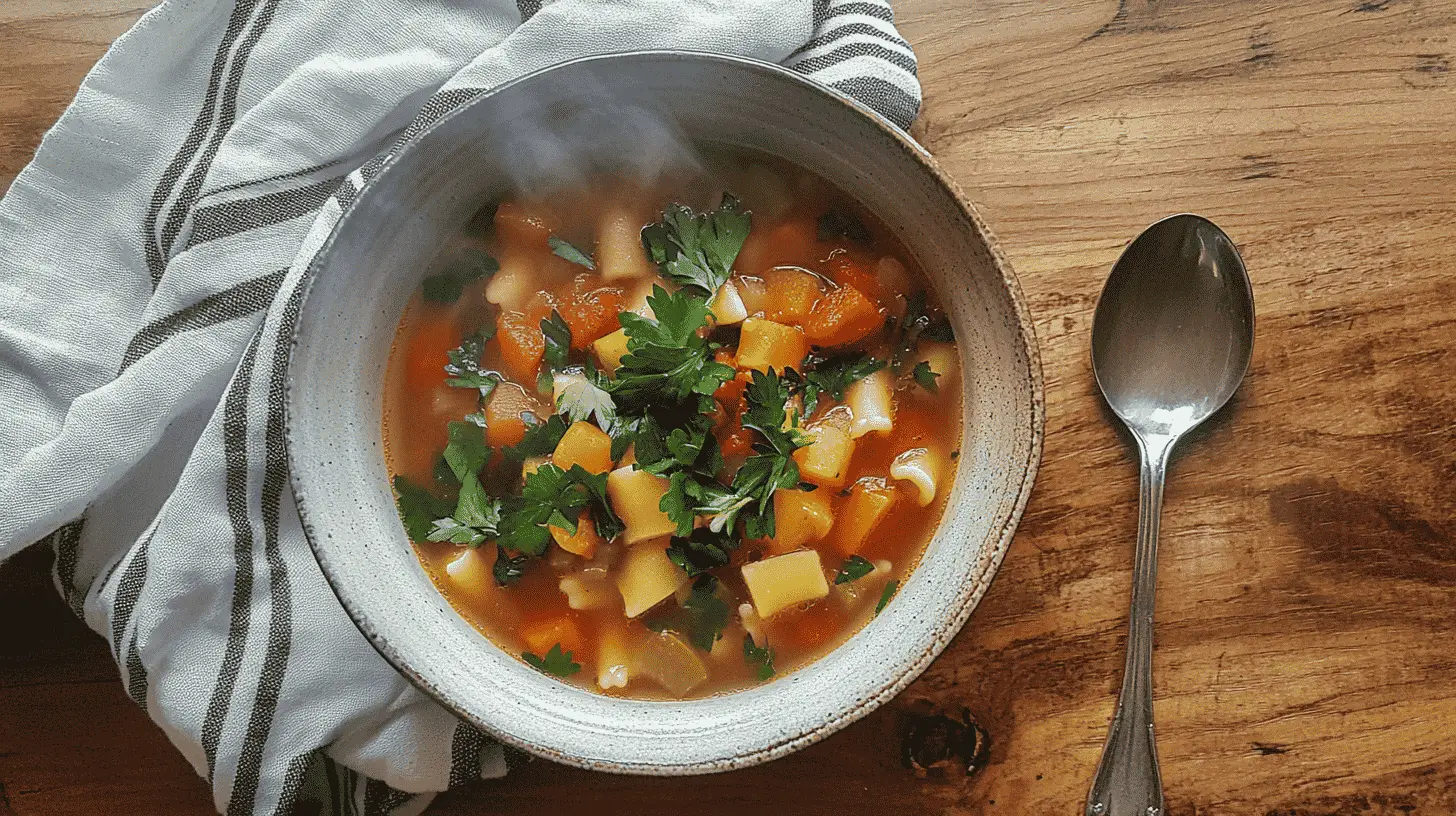Table of Contents
Pasta lovers, rejoice! This ditalini pasta recipe guide takes you through the delicious and versatile world of ditalini, a tiny, tube-shaped pasta perfect for soups, salads, and more. Whether you’re a seasoned cook or a kitchen newbie, this guide has everything you need. From learning the origins of ditalini to discovering creative and healthy recipes, you’ll find endless inspiration to make it a staple in your meals. Let’s dive in and make ditalini pasta the star of your culinary repertoire!
Introduction to Ditalini Pasta
What is Ditalini Pasta?
Ditalini pasta, also known as “little thimbles” in Italian, is a small, tubular pasta that’s beloved for its versatility. Often used in soups like minestrone, this pasta shape is equally at home in creamy casseroles, fresh salads, and even hearty stews. Its compact size makes it perfect for soaking up flavors and creating balanced bites.
Origin and History of Ditalini Pasta
Hailing from Southern Italy, ditalini pasta has a rich culinary heritage. It was traditionally crafted to complement the region’s simple yet flavorful recipes, often featuring seasonal vegetables and hearty broths. Over time, it gained global popularity, becoming a staple in Italian-American kitchens and beyond.
Why Choose Ditalini for Your Recipes?
So, why is ditalini pasta such a hit in the kitchen? For starters, its shape and size allow it to hold onto sauces, dressings, and broths like a pro. Its adaptability means you can use it in virtually any dish, from light summer salads to comforting winter soups. Plus, it cooks quickly, making it a favorite for busy weeknight meals.
With ditalini, the culinary possibilities are endless, and we’re just getting started!
Ditalini Pasta vs. Similar Types
Difference Between Ditalini and Ditali Pasta
One common question among pasta enthusiasts is, “What’s the difference between ditalini and ditali pasta?” While both are small, tube-shaped varieties, ditalini pasta is notably shorter and thinner. Ditali, on the other hand, has a slightly larger diameter, making it ideal for heartier dishes like baked pasta or chunky sauces.
Ditalini’s petite size makes it the perfect choice for recipes like soups and salads, where balance in every spoonful matters. Whether you’re using it in traditional minestrone or a creamy pasta dish, its adaptability shines through.
What is Ditalini Pasta Similar To?
If you don’t have ditalini on hand, don’t fret! Close alternatives include small pasta varieties like orzo, elbow macaroni, or small shells. Each of these shapes offers a similar bite-size experience, though their texture and sauce-holding capabilities vary slightly. For example, cavatappi works well in casseroles, while orzo is a star in salads and broths.
For more about cavatappi pasta and its versatility in recipes, you can explore related ideas on Cavatappi Pasta Recipes.
How to Cook Ditalini Pasta Perfectly

Step-by-Step Guide to Cooking Ditalini
Cooking ditalini pasta to perfection is a breeze when you follow these steps:
- Bring a large pot of salted water to a rolling boil. Use about 4 quarts of water for every pound of pasta.
- Add the ditalini and stir gently to prevent sticking.
- Cook for 8–10 minutes, or until al dente. Test a piece to ensure it’s firm but cooked through.
- Drain immediately and rinse with cold water if you’re using it in a salad. For hot dishes, toss with a bit of olive oil to keep the pasta from clumping.
Tips for Al Dente Ditalini Pasta
Want that perfect al dente texture? Here are some tips:
- Always use enough water to let the pasta move freely.
- Stir occasionally during cooking to keep the tubes from sticking together.
- Avoid overcooking, as ditalini can become mushy quickly.
Common Mistakes to Avoid While Cooking Ditalini
Even seasoned cooks can make a few blunders. To keep your ditalini pasta recipe flawless:
- Don’t add oil to the boiling water; it prevents sauces from sticking.
- Avoid skimping on salt, it’s the only chance to season the pasta itself.
- Never leave cooked pasta sitting in the colander, it’ll clump and lose its texture.
Ditalini Pasta Recipes for Every Occasion

Classic Ditalini Pasta Soup
One of the most popular ways to use ditalini pasta is in soups. Its small, tube-like shape makes it ideal for hearty broths and chunky ingredients. Minestrone, a classic Italian soup, is a prime example. Packed with seasonal vegetables, beans, and a light tomato base, this soup pairs beautifully with ditalini’s texture.
For a quick variation, try chicken noodle soup with ditalini, it’s comforting, filling, and perfect for cold days.
Creamy Ditalini Pasta with Vegetables
For a creamy, veggie-packed dish, pair ditalini with a velvety cheese or Alfredo sauce. Add steamed broccoli, peas, and sautéed mushrooms for a wholesome, satisfying meal. This ditalini pasta recipe is perfect for weeknight dinners, as it comes together in under 30 minutes.
Ditalini Salad for Summer
When summer rolls around, ditalini shines in pasta salads. Toss it with cherry tomatoes, cucumbers, olives, and feta cheese for a Mediterranean-inspired dish. Dress it with olive oil, lemon juice, and fresh herbs to highlight its flavors. Not only is this salad light and refreshing, but it also travels well for picnics or potlucks.
Ditalini Pasta with Tomato Sauce and Meat
For a heartier option, go with a classic tomato sauce. Add ground beef or Italian sausage for a protein boost, and let the pasta simmer in the sauce for a few minutes to absorb its rich flavor. Serve with a sprinkle of Parmesan cheese and freshly cracked black pepper. This comforting dish is a family favorite for good reason!
For other innovative pasta ideas, explore our guide on Cavatappi Pasta Recipes.
Healthy and Nutritional Aspects of Ditalini Pasta
Is Ditalini Pasta Healthy?
The healthiness of ditalini pasta largely depends on how it’s prepared. On its own, ditalini is a great source of carbohydrates, which provide energy. For a more nutritious option, opt for whole-grain or gluten-free varieties. These alternatives offer more fiber and essential nutrients without compromising taste.
Nutritional Profile of Ditalini Pasta
A typical serving of ditalini pasta (about 2 ounces dry) contains:
- Calories: ~200
- Protein: 7 grams
- Carbohydrates: 42 grams
- Fiber: 2 grams
To make it more balanced, pair it with lean proteins like chicken or fish, and load up on vegetables for added fiber and vitamins.
Tips for Making a Healthy Ditalini Dish
Here are some ideas to keep your ditalini pasta recipe both delicious and healthy:
- Use olive oil-based dressings instead of cream-based sauces.
- Add plenty of veggies like zucchini, spinach, or bell peppers to increase the nutrient content.
- Swap out regular pasta for whole-wheat ditalini for added fiber and a nuttier flavor.
For another flavorful Italian soup featuring ditalini, check out Memé’s Pasta Fagioli. This traditional dish combines ditalini with white beans and a rich tomato broth, making it a must-try for pasta lovers.
Creative Additions to Elevate Your Ditalini Dish
What Can I Add to Pasta to Make It More Interesting?
Taking your ditalini pasta recipe to the next level is easier than you might think. Start by incorporating fresh, bold ingredients like sun-dried tomatoes, roasted garlic, or caramelized onions. These add a depth of flavor that pairs beautifully with ditalini’s subtle taste.
For a creamy touch, mix in a dollop of ricotta or mascarpone cheese. If you prefer some crunch, sprinkle toasted breadcrumbs or pine nuts on top, this adds texture and a rich, nutty flavor.
Best Sauces for Ditalini Pasta
The beauty of ditalini pasta lies in its ability to hold onto sauces. Here are some sauce ideas to inspire your next dish:
- Classic Marinara: A simple tomato sauce is always a crowd-pleaser. Add fresh basil for an aromatic twist.
- Pesto: Basil or spinach pesto provides a vibrant, herby kick.
- Alfredo: A creamy Alfredo sauce clings perfectly to the small pasta tubes, creating a rich and indulgent experience.
- Lemon Butter: For a light, zesty option, try a lemon-butter sauce with fresh parsley.
Unique Toppings and Ingredients to Try
Experiment with unexpected toppings to transform your pasta. Try crispy pancetta, sautéed shrimp, or a soft-boiled egg for added protein. Vegetarians can load up on grilled eggplant or artichoke hearts for a Mediterranean vibe.
Herbs like thyme, oregano, or chives make wonderful finishing touches, elevating even the simplest recipes. A drizzle of high-quality olive oil or balsamic glaze adds complexity and sophistication.
Pairing Ditalini Pasta with Drinks and Sides
Perfect Wine and Beverage Pairings for Ditalini
Choosing the right drink can enhance the flavors of your ditalini pasta recipe. For tomato-based dishes, a medium-bodied red wine like Chianti or Sangiovese works wonderfully. Creamy or cheesy pasta pairs well with a crisp white wine, such as Sauvignon Blanc or Chardonnay.
Prefer non-alcoholic options? Sparkling water with a splash of citrus is refreshing and complements rich pasta dishes without overpowering the flavors.
Best Side Dishes to Complement Ditalini Pasta
Balance your meal by pairing ditalini pasta with simple yet flavorful sides. A fresh garden salad with a tangy vinaigrette is a classic choice. Garlic bread or bruschetta can add a satisfying crunch and soak up any extra sauce.
For heartier meals, roasted vegetables like zucchini, bell peppers, or asparagus bring a touch of smokiness. If you’re serving soup with ditalini, consider a side of crusty bread for dipping, it’s comforting and delicious!
Frequently Asked Questions About Ditalini Pasta
What is the Difference Between Ditalini and Ditali Pasta?
Though their names sound similar, ditalini and ditali pasta have subtle differences. Ditali is slightly larger and thicker, making it ideal for baked dishes or hearty sauces. On the other hand, ditalini pasta is smaller and more delicate, which is why it’s often used in soups and salads. Both shapes are versatile, but ditalini excels when you need a pasta that blends seamlessly into every bite.
What is Ditalini Pasta Similar To?
If you can’t find ditalini, other small pasta shapes like orzo, small shells, or elbow macaroni make excellent substitutes. Each option has a unique texture, but all work well in recipes calling for ditalini. For soups, orzo is a close match, while small shells are great for holding creamy sauces.
Is Ditalini Pasta Healthy?
The answer depends on how it’s prepared. Ditalini pasta itself is a good source of energy-rich carbohydrates. To make a healthy ditalini pasta recipe, use whole-grain varieties, add plenty of vegetables, and avoid heavy cream-based sauces. A balanced dish keeps the pasta delicious and nutritious.
What Can I Add to Pasta to Make It More Interesting?
Fresh herbs, flavorful cheeses, and crunchy toppings can all elevate your pasta dish. Experiment with capers, olives, roasted veggies, or even a hint of lemon zest to keep your meals exciting. These additions complement the versatility of ditalini beautifully.

Ditalini Pasta Recipe
Equipment
- Large Pot
- Strainer
- Mixing Bowl
Ingredients
Base Ingredients
- 8 oz ditalini pasta
- 4 cups water for boiling pasta
- 1 tsp salt for seasoning pasta water
For Salad Option
- 1 cup cherry tomatoes halved
- ½ cup cucumber diced
- ¼ cup feta cheese crumbled
- 2 tbsp olive oil
- 1 tbsp lemon juice freshly squeezed
- fresh basil chopped, for garnish
For Soup Option
- 4 cups vegetable broth
- 1 can diced tomatoes 14.5 oz
- 1 cup white beans drained and rinsed
- 1 tsp Italian seasoning
Instructions
- Bring a large pot of salted water to a boil. Add ditalini pasta and cook for 8-10 minutes until al dente. Drain and set aside.
- For Salad: In a mixing bowl, combine cooked ditalini, cherry tomatoes, cucumber, feta cheese, olive oil, lemon juice, and fresh basil. Toss well and serve chilled.
- For Soup: In a large pot, heat vegetable broth over medium heat. Add diced tomatoes, white beans, and Italian seasoning. Simmer for 10 minutes, then stir in cooked ditalini pasta. Serve warm.
Notes
✅ Use whole-wheat ditalini for a fiber-rich option.
✅ Add a sprinkle of Parmesan cheese for extra flavor.
Conclusion and Final Thoughts
Why Ditalini Pasta Should Be a Staple in Your Kitchen
Ditalini pasta is a culinary gem that deserves a spot in every pantry. Its small size and versatile shape make it a perfect choice for soups, salads, and hearty entrees. Whether you’re crafting a comforting ditalini pasta recipe or experimenting with new flavors, it’s a pasta that never disappoints.
Encouraging Readers to Try the Recipes
With endless ways to prepare it, ditalini pasta offers something for everyone. From classic tomato sauces to creamy Alfredo dishes, there’s no shortage of options to explore. Plus, its adaptability makes it easy to incorporate into healthy meals, indulgent treats, or quick weeknight dinners.
Final Tips for Experimenting with Ditalini
Don’t be afraid to get creative with your ditalini pasta recipe. Use fresh, seasonal ingredients to keep your dishes vibrant and flavorful. Mix in unique sauces, toppings, and sides to make every meal special. And, most importantly, enjoy the process of cooking and sharing this delightful pasta with friends and family.


1 thought on “Ditalini Pasta Recipe: Perfect Dishes for Soups, Salads, and More”